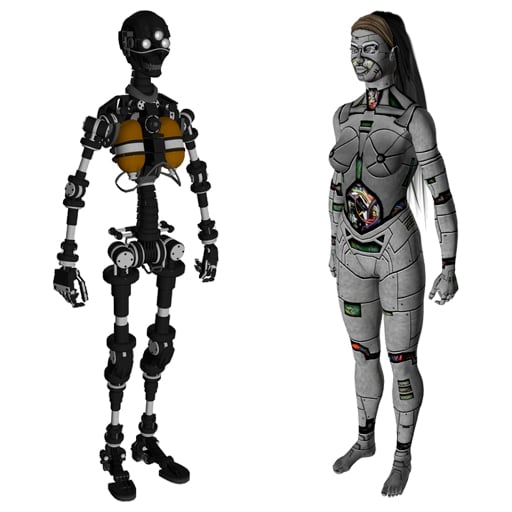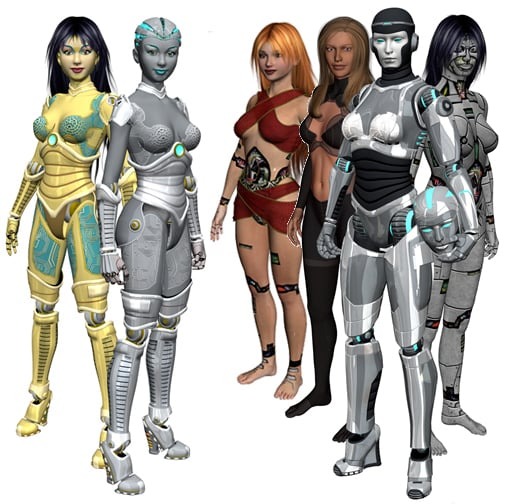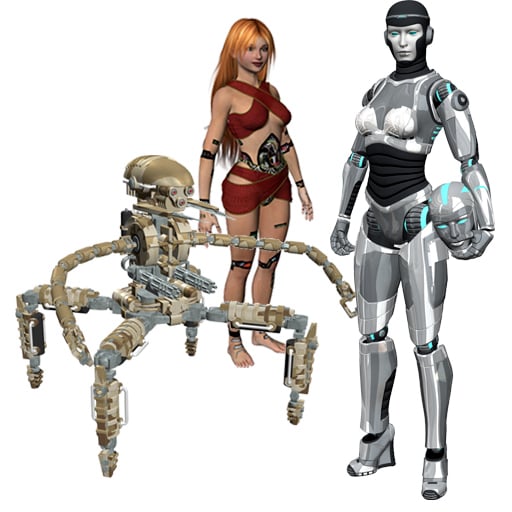

The history of androids is actually a history of robotics or rather one aspect of robotics. It is a kind of quest to create a machine that looks and acts or rather reacts like a human. From the time man pulled upon the strings of the first puppet he has dreamed of a puppet without strings. You might call it the “Pinocchio syndrome,” but whatever you call it, humanity has dreamed of creating artificial life. Almost from the beginning of time there have been fictional stories that have followed that theme.
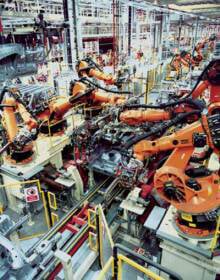
There is no single correct definition of "robot". For robotic engineers, the physical appearance of a machine is less important than the way its actions are controlled. The more the control system seems to have agency of its own, the more likely the machine is to be called a robot. For many laymen, if a machine appears to be able to control its arms or limbs, and especially if it appears anthropomorphic or zoomorphic it would be called a robot. A 3-axis CNC milling machine using the same control system as a robot arm, it is the arm which is almost always called a robot, while the CNC machine is usually just a machine. Having eyes can also make a difference in whether a machine is called a robot, since humans instinctively connect eyes with sentience. However, simply being anthropomorphic is not a sufficient criterion for something to be called a robot; a robot must do something.
The word robot was introduced to the public by Czech writer Karel Čapek in his play R.U.R. (Rossum's Universal Robots), which premiered in 1921. The play begins in a factory that makes artificial people called robots, but they are closer to the modern ideas of androids and clones, creatures who can be mistaken for humans. They can plainly think for themselves, though they seem happy to serve. At issue is whether the robots are being exploited and the consequences of their treatment. The word "robota" means literally work, labor or serf labor, and figuratively "drudgery" or "hard work" in Czech and many Slavic languages. Isaac Asimov coined the term robotics without suspecting that it might be an original word at the time. The word robotics continues in mainstream technical use with Asimov's original definition.
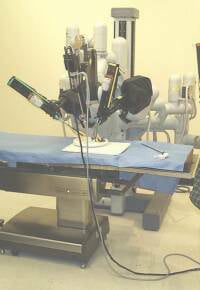
In science fiction, the Three Laws of Robotics are a set of three rules written by Isaac Asimov, which almost all positronic robots appearing in his fiction must obey. Introduced in his 1942 short story "Runaround", although foreshadowed in a few earlier stories, the Laws state the following: A robot may not injure a human being or, through inaction, allow a human being to come to harm. A robot must obey orders given to it by human beings, except where such orders would conflict with the First Law. A robot must protect its own existence as long as such protection does not conflict with the First or Second Law. Asimov attributes the Laws to John W. Campbell from a conversation that took place on 23 December 1940. However, Campbell claimed that Asimov had the Laws already in his mind, and they simply needed to be stated explicitly. In a later essay, Asimov points out that analogues of the Laws are implicit in the design of almost all tools: A tool must be safe to use. (Knives have handles, swords have hilts, and grenades have pins.) A tool must perform its function efficiently unless this would harm the user. A tool must remain intact during its use unless its destruction is required for its use or for safety.
The idea of robots has been with us throughout time. In the 4th century BC, the Greek mathematician Archytas of Tarentum postulated a mechanical steam-operated bird he called "The Pigeon". Hero (Heron) of Alexandria (10–70 AD) created numerous user-configurable automated devices, and described machines powered by air pressure, steam and water. Su Song built a clock tower in China in 1088 featuring mechanical figurines that chimed the hours. Al-Jazari (1136–1206), a Muslim inventor during the Artuqid dynasty, designed and constructed a number of automated machines, including kitchen appliances, musical automata powered by water, and the first programmable humanoid robots in 1206. Even Leonardo da Vinci (1452–1519) sketched plans for a humanoid robot around 1495 and in 1738 and 1739, Jacques de Vaucanson exhibited several life-sized automatons. The Japanese craftsman Hisashige Tanaka (1799–1881), known as "Japan's Edison", created an array of extremely complex mechanical toys. In 1926, Westinghouse Electric Corporation created Televox, the first robot put to useful work. The first electronic autonomous robots were created by William Grey Walter of the Burden Neurological Institute at Bristol, England in 1948 and 1949. The first truly modern robot, digitally operated and programmable, was invented by George Devol in 1954 and was ultimately called the Unimate.
Much of the research in robotics focuses not on specific industrial tasks, but on investigations into new types of robots, alternative ways to think about or design robots, and new ways to manufacture them.
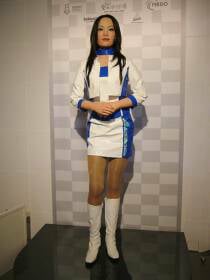
Fears and concerns about robots have been repeatedly expressed in a wide range of books and films. A common theme is the development of a master race of conscious and highly intelligent robots, motivated to take over or destroy the human race. The first fatality involving a robot was Robert Williams, who was struck by a robotic arm at a casting plant in Flat Rock, Michigan on January 25, 1979. The second was 37-year-old Kenji Urada, a Japanese factory worker, in 1981. Urada was performing routine maintenance on the robot, but neglected to shut it down properly, and was accidentally pushed into a grinding machine.
An android is a robot designed to look and act human. The word derives from ανδρός, the genitive of the Greek ανήρ anēr, meaning "man", and the suffix -eides, used to mean "of the species; alike" (from eidos, "species"). Though the word derives from a gender-specific root, its usage in English is usually gender neutral. The term was first mentioned by St. Albertus Magnus in 1270 and was popularized by the French writer Villiers in his 1886 novel L'Ève future, although the term "android" appears in US patents as early as 1863 in reference to miniature humanlike toy automations.
Gynoid (from Greek γυνη, gynē - woman) is a term used to describe a robot designed to look like a human female, as compared to an android modeled after a male. The term is not common, however, with android often being used to refer to both "genders" of robot. The portmanteau fembot (female robot) has also been used.
Disney animatronics were essentially life-size puppets and Actroids were the first truly human looking robots. The skin was often composed of silicone and appeared highly realistic. The compressed air that powers the robot's servo motors, and most of the computer hardware that operates the A.I., and in the case of the Actroids, are external to the unit. This is a contributing factor to the robot's lack of locomotion capabilities. The interactive Actroids can communicate on a rudimentary level with humans by speaking. Microphones within those Actroids record the speech of a human, and this sound is then filtered to remove background noise - including the sounds of the robot's own operation. Speech recognition software is then used to convert the audio stream into words and sentences, which can then be processed by the Actroid's A.I. A verbal response is then given through speakers external to the unit. When addressed, the interactive Actroids used a combination of "floor sensors and omni-directional vision sensors" in order to maintain eye contact with the speaker. In addition, the robots can respond in limited ways to body language and tone of voice by changing their own facial expressions, stance and vocal inflection. Even though a number of autonomous robots have been created they have always been limited by their programming or remotely controlled. The true android as envisioned in numerous stories escape humanity's grasp.
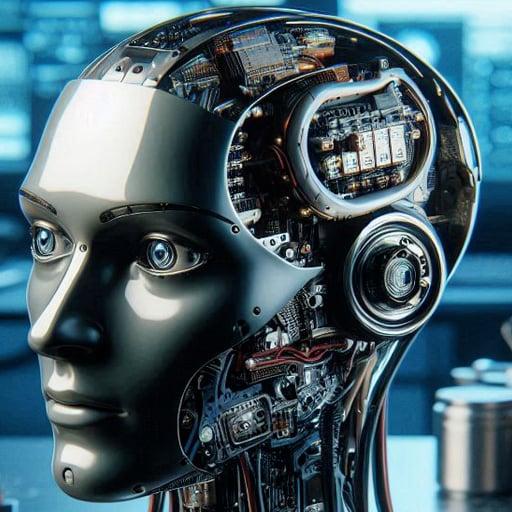
In 2042 a new microchip called the A.I. chip hit the market. This chip would give any robot that used it a certain amount of freewill. First used in children’s toys, the new chip would soon take the world by storm. The A.I. chip gave these toys the ability to be interactive in a way never before imagined. It was hailed as one of the greatest advances in microchip technology ever. A new line of toys called 'companion toys' became the rage. Companion toys were not just some toy; they were also playmates, teachers and friends for children. These toys demonstrated to the world one aspect of the endless possibilities of what the A.I. chip was capable of doing. As they began putting the new chip into everything, smart houses took on a whole new meaning.
With the invention of the A.I. chip the race to build service robots was on. The first true androids rolled off the assembly line in 2045. Before that what passed for androids were nothing more than very sophisticated robots that often required years of programming on the R&D end of things. Those early robots were little more than high tech toys. The A.I. chips changed all that, needing far less programming, giving androids only the boundaries in which they could operate.
Enter Cybertron Robotics as the first company devoted solely to the manufacture of service androids. Given the state of robotics at the time no one thought that the company would amount to much. However, Thomas Roth, CEO of Cybertron Robotics, was able to assemble some of the finest young minds on the planet including some of the people who helped design the original A.I. chip. Following several major breakthroughs the first true androids approximating humans in appearance was created by Cybertron Robotics in 2051.
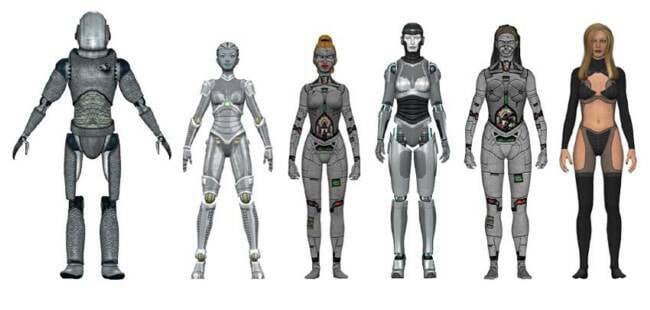
One of the androids created was the very popular line of service androids known as the April model which, at the time, had the same basic structure as their line of personal companion androids, only they were built out of much tougher material. The April model would be upgraded in 2074 when a new line of service androids were introduced to the world. This was the Daisy May series and while not overly popular in heavy industry they were quickly snapped up for other more mundane services. The Sally Ann series would replace the Daisy Mays 28 years later. Their Kevlar plates and nano-skin is thicker making them much tougher and somewhat bulletproof. They are also a little taller and almost twice as strong. The military complex and security industry fell in love with them. The April model was intended to be replaced with the June model. While the Sally Ann model is just as strong as the old April models it is almost as tough and even more versatile.
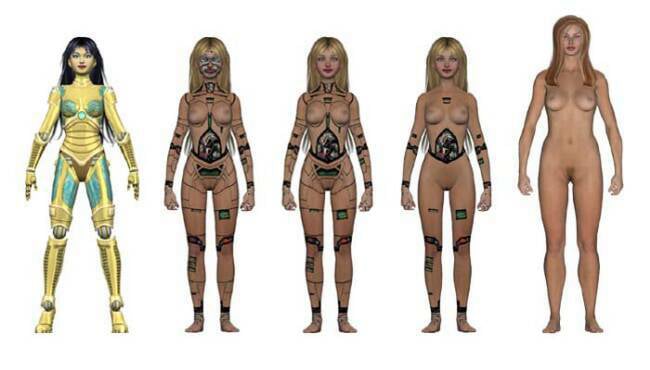
The first true female personal companion android was one of the first androids created in 2051. Anatomically correct in every way they were designed to entertain and be companions of a very personal nature. The first model was named Candy. Four other models would follow, Sugar, Honey, Angel 1 and the new Angel 2 model. After the Angel 2 personal companion android no other model upgrades have been made at this time.
Skin covering was always an issue with the personal companion androids. Most rubber like materials tended to break down over time. Heavy abuse that the personal companion androids often experienced was also a factor as some skin material damaged easily. Most personal companion androids had to be re-skinned every couple of years.
In 2063 a thin flexible material called, "nano-skin," was developed with the hope of replacing severely damaged skin tissue so that a person could still feel sensations of touch, hot and cold as they could have before they were injured. The material was never a success in human trials but found a market with android manufactures that created a whole new series of personal android companions who looked, felt, and functioned almost like their human counterparts.
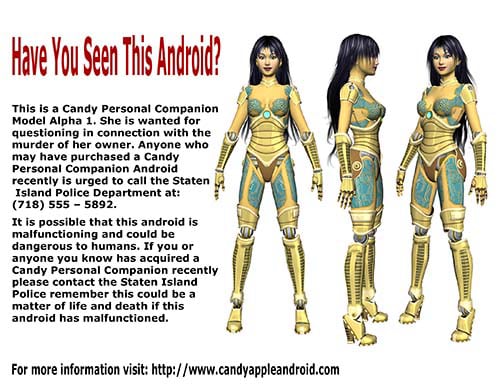
In 2074 a programming bug and a flaw in the first Law of Robotics was discovered when a Candy Personal Companion Model accidentally killed her owner. The first law states: A robot may not injure a human being or, through inaction, allow a human being to come to harm. A robot has to recognize that what it is doing will cause harm to a human in order to obey any programming designed to prevent the robot from harming a human. After the incident in 2074 all androids would come with the warning that states: Physically abusing an android/robot/A.I. will void the warranty and might cause the android/robot/A.I. to malfunction and consequential damages that may be caused by the android/robot/A.I. will not be covered under the manufacture's warranty.
There are all kinds of androids for all kinds of uses. Military robots come in all kinds of shapes and sizes some of which can come under the heading of android being somewhat humanoid in appearance. Service androids and robots made for various industries is by far the most numerous of the automatons in use today.
The newest personal companion androids Cybertron Robotics makes all come with the latest advancements in nano-skin technology. While earlier versions of nano-skin tended to tear when subjected to stress which required the joints be left exposed. The new nano-skin no longer has that problem and so our new Angel 2 android model looks and feels even more real than before. The new nano-skin has even better self-regenerative properties making the Angel 2 models more durable too.
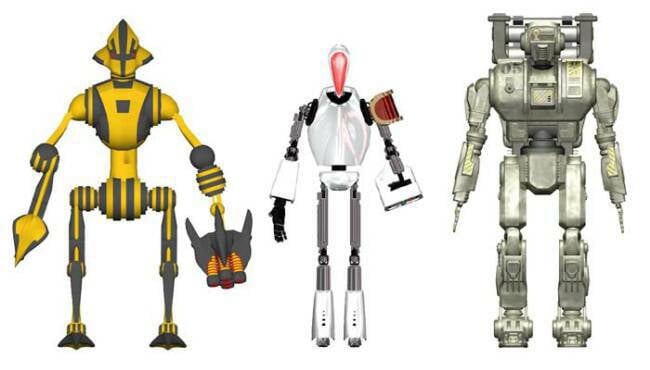
Certainly,there are other android manufacturing companies but few that have advanced android development as much as Cybertron Robotics. With their newest models of service and personal companion androids they are taking android development to a whole new level.
